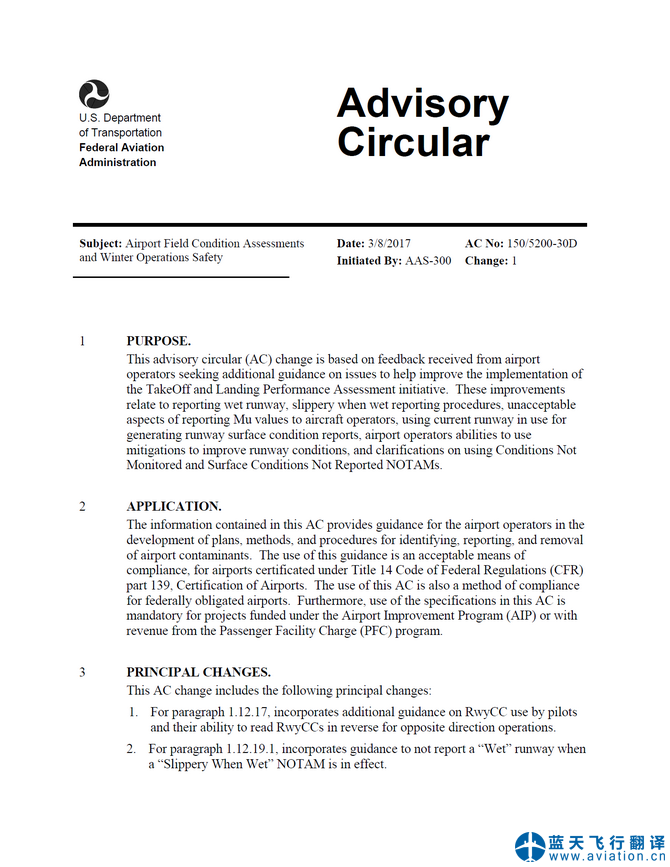时间:2020-03-15 10:34来源:蓝天飞行翻译公司 作者:民航翻译 点击:次
|
北京蓝天飞行翻译公司承接大型航校的FAA咨询通告机场条件评估和冬季运行安全翻译任务 FAA Advisory Circular Airport Field Condition Assessments and Winter Operations Safety Translation
 FAA咨询通告机场条件评估和冬季运行安全 咨询通告编号: 150/5200-30D FAA咨询通告机场条件评估和冬季运行安全(Airport Field Condition Assessments and Winter Operations Safety)的主要内容包含有:
INTRODUCTION Overview Background Snow and Ice Control Committee Airport Snow and Ice Control Committee (SICC) Snow Control Center (SCC) Airfield Clearing Priorities for the Snow and Ice Control Plan (SICP) Terminal and Landside – Ground Side Priority Airfield Target Clearance Times Staffing for Operation of Snow and Ice Control Equipment Sizing and Storage of Snow and Ice Control Equipment FAA-Approved Runway Friction Measuring Equipment Definitions THE SNOW AND ICE CONTROL PLAN Safety Requirements Airport Operators Snow and Ice Control Plans Topics for Pre- and Post-Season SICC Meetings Outlining a Snow and Ice Control Plan (SICP) Topics for Writing Instructions and Procedures for Winter Operations and Notification Runway Incursion Mitigation and Operations During Non-Towered Air Traffic Control Periods Staff Training and Recordkeeping Other Related Items FORECAST TECHNOLOGY FOR AIRPORT OPERATORS Weather Forecasting FAA Forecasting Research and Development for Airport Operators Forecasting Runway Surface Conditions SNOW CLEARING OPERATIONS AND ICE PREVENTION Introduction Snow Clearing Principles Controlling Snow Drifts Snow Disposal Methods for Ice Control and Removal Approved Chemicals Runway Friction Improvements Sand SURFACE ASSESSMENT AND REPORTING Airport Operator Responsibility Runway Friction Surveys Runway Condition Assessments Applying the RCAM to a Runway Assessment Reportable Contaminants without Performance Data Condition Reporting Information Exchanged Between the Airport and Pilots Requirements for Runway, Taxiway, and Apron and Holding Bay Closures Continuous Monitoring Letter of Agreement (LOA) Between Airport Operator and Air Traffic Control Tower Airport Records and Log Controls Using “Conditions Not Monitored” NOTAMs “Surface Conditions Not Reported” NOTAMs Winter NOTAM Abbreviations SAMPLE AIRPORT CONDITIONS ASSESSMENT WORKSHEET DEVELOPMENT OF RECOMMENDED SNOW BANK HEIGHT PROFILES SNOW AND ICE CONTROL AS A MATERIALS-HANDLING PROBLEM APPENDIX D. DECELEROMETERS THAT MEET FAA TECHNICAL SPECIFICATIONS PERFORMANCE SPECIFICATION FOR DECELEROMETERS RUNWAY CONDITION ASSESSMENT MATRIX (RCAM) (FOR AIRPORT OPERATORS’ USE ONLY) Ash Ash is a grayish-white to black solid residue of combustion normally originating from pulverized particulate matter ejected by volcanic eruption. Compacted Snow Compacted snow is snow that has been compressed and consolidated into a solid form that resists further compression such that an airplane will remain on its surface without displacing any of it. If a chunk of compressed snow can be picked up by hand, it will hold together or can be broken into smaller chunks rather that falling away as individual snow particles. Note: A layer of compacted snow over ice must be reported as compacted snow only. Example: When operating on the surface, significant rutting or compaction will not occur. Compacted snow may include a mixture of snow and embedded ice; if it is more ice than compacted snow, then it should be reported as either ice or wet ice, as applicable. Contaminant. A contaminant is a deposit such as frost, any snow, slush, ice, or water on an airport pavement where the effects could be detrimental to the friction characteristics of the pavement surface. |